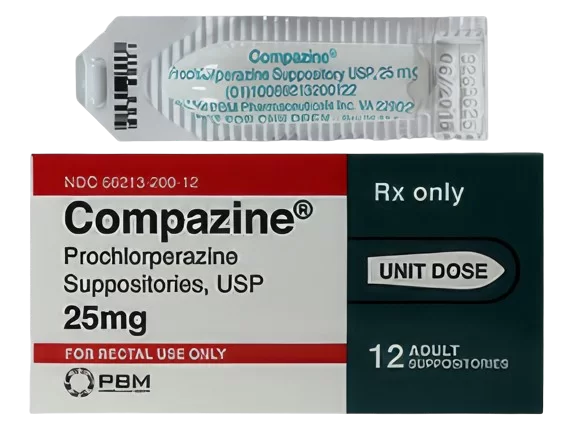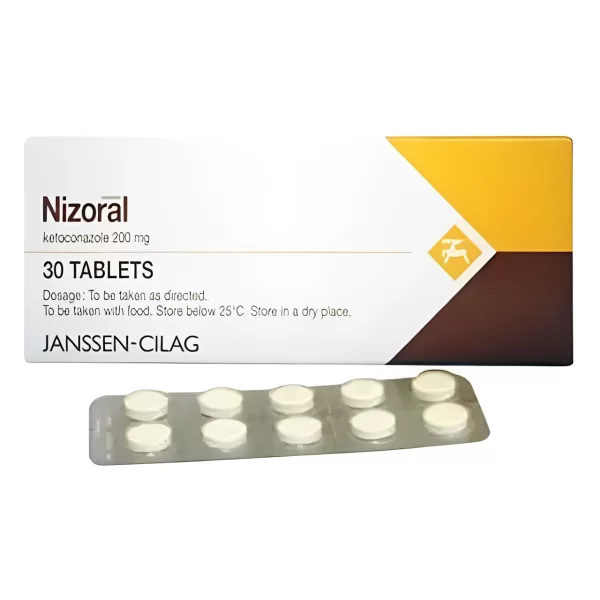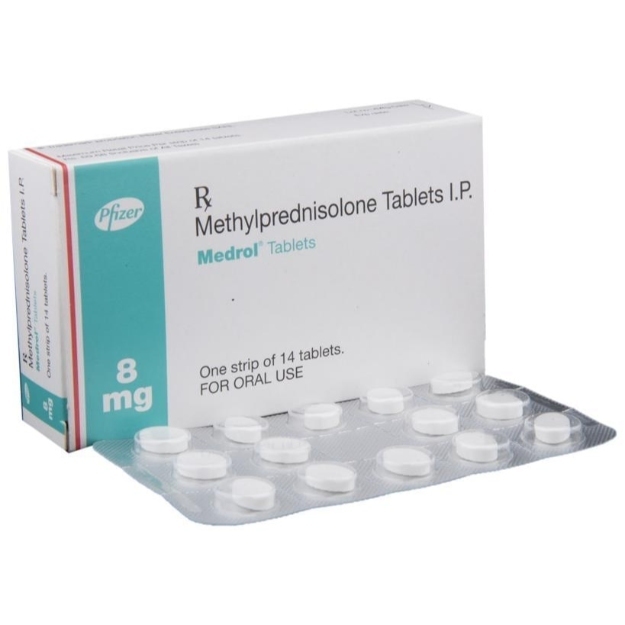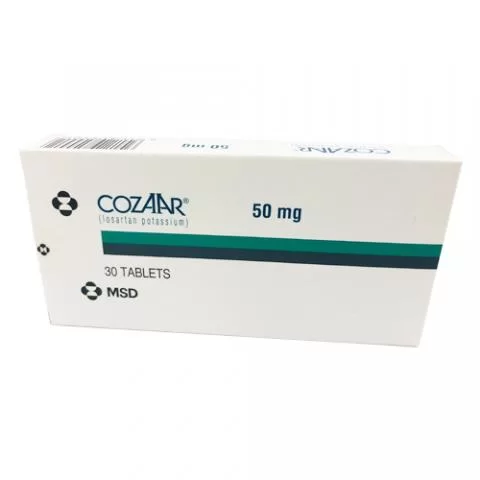
Compazine
Compazine - 5mg
Overview of Compazine
General Introduction
Compazine, generically known as Prochlorperazine, is a medication primarily used to control severe nausea and vomiting, as well as to treat schizophrenia and anxiety. It belongs to the class of drugs known as phenothiazines, which work by blocking dopamine receptors in the brain, thereby helping to manage symptoms of nausea, vomiting, and psychotic disorders. Compazine is available in multiple forms, including tablets, suppositories, and injections, providing flexibility in its administration depending on the patient’s needs and the severity of symptoms.
Key Points
- Medication Name: Compazine (Prochlorperazine)
- Class: Phenothiazines
- Primary Use: Control of severe nausea and vomiting, treatment of schizophrenia and anxiety
- Administration: Oral tablets, rectal suppositories, intramuscular or intravenous injection
- Dosage: Typically varies based on the condition being treated and the form of medication used
Compazine works effectively for its indicated uses due to its mechanism of action, which primarily involves blocking dopamine D2 receptors in the brain. By doing so, it not only alleviates the symptoms of nausea and vomiting but also exerts antipsychotic effects, making it useful in the management of schizophrenia and severe anxiety. This broad spectrum of activity makes Compazine a versatile medication in both the gastrointestinal and psychiatric treatment areas.
Indications for Use of Compazine
Key Indications
- Severe Nausea and Vomiting: Effective in managing symptoms regardless of the underlying cause.
- Schizophrenia: Helps control psychotic symptoms such as delusions, hallucinations, and disorganized thinking.
- Severe Anxiety: Provides relief for patients with intense anxiety not managed by other medications.
For nausea and vomiting, the typical adult dose ranges from 5 to 10 mg three to four times daily, with adjustments based on patient response and severity of symptoms. For schizophrenia, initial doses often start at 5 to 10 mg three to four times daily, with maintenance doses adjusted according to the therapeutic response. When used for anxiety, lower doses are generally recommended.
Dosage and Administration of Compazine
Dosage Instructions
- Oral Tablets: 5-10 mg, three to four times daily
- Rectal Suppositories: 25 mg twice daily
- Injection: 2.5 mg to 10 mg, depending on severity and route
Administration Tips
- Oral Use: Take with or without food, depending on patient tolerance.
- Suppository Use: Insert rectally, typically twice daily.
- Injection Use: Administered by healthcare professionals, typically in a clinical setting.
For optimal results, it is crucial to adhere to the prescribed dosage and administration guidelines. The healthcare provider may adjust the dose based on the patient's response and any side effects experienced. It is important to follow the prescribed schedule closely to ensure the effectiveness of the treatment and to minimize the risk of adverse effects.
Mechanism of Action of Compazine
Compazine works by blocking dopamine D2 receptors in the brain. Dopamine is a neurotransmitter that plays a significant role in mood regulation, nausea, vomiting, and the reward system. By inhibiting dopamine receptors, Compazine helps reduce the symptoms of nausea and vomiting and exerts antipsychotic effects. This dual action makes it particularly useful in treating both gastrointestinal symptoms and psychiatric disorders.
Mechanism Details
- Dopamine Receptor Antagonist: Blocks D2 receptors in the brain.
- Antiemetic Effect: Reduces nausea and vomiting by inhibiting the action of dopamine in the chemoreceptor trigger zone (CTZ) of the brain.
- Antipsychotic Effect: Alleviates symptoms of schizophrenia by modulating dopamine activity in the brain.
The therapeutic effects of Compazine in managing nausea and vomiting are due to its ability to inhibit the dopamine-mediated signaling pathways in the CTZ, which is responsible for triggering the vomiting reflex. In the context of psychiatric disorders, blocking dopamine receptors helps to balance neurotransmitter levels, thereby reducing psychotic symptoms. This makes Compazine a valuable option for patients suffering from both severe nausea and psychiatric conditions.
Composition of Compazine
Composition
- Active Ingredient:Prochlorperazine
- Oral Tablets: Available in strengths of 5 mg and 10 mg.
- Rectal Suppositories: Typically available in 25 mg strength.
- Injectable Solutions: Available in various concentrations for intramuscular or intravenous administration.
Inactive Ingredients
- Oral Tablets: May contain lactose, magnesium stearate, microcrystalline cellulose.
- Rectal Suppositories: Typically include cocoa butter or other bases that facilitate rectal absorption.
- Injectable Solutions: Usually contain sodium chloride, water for injection, and possibly preservatives or stabilizers.
The choice of formulation depends on the patient’s condition, the severity of symptoms, and their ability to tolerate different routes of administration. The flexibility in dosage forms allows for tailored treatment plans that can maximize efficacy and minimize discomfort or inconvenience for the patient.
Side Effects of Compazine
Common Side Effects
- Drowsiness
- Dizziness
- Blurred vision
- Dry mouth
- Constipation
Severe Side Effects
- Extrapyramidal Symptoms (EPS): Tremors, muscle stiffness, involuntary movements.
- Jaundice: Yellowing of the skin or eyes, indicating potential liver issues.
- Low Blood Pressure: Dizziness or fainting upon standing.
- Neuroleptic Malignant Syndrome (NMS): High fever, muscle rigidity, altered mental status.
Patients experiencing severe side effects should seek immediate medical attention. Regular monitoring by a healthcare provider is essential to manage any adverse effects and adjust the dosage as needed. Patients should be informed of the potential side effects and advised to report any unusual symptoms promptly to ensure timely intervention and support.
Prevention of Side Effects of Compazine
To minimize side effects, it is crucial to follow the prescribed dosage and administration guidelines. Starting with the lowest effective dose can help reduce the risk of severe side effects. Patients should avoid alcohol and other central nervous system depressants while taking Compazine, as these can exacerbate drowsiness and dizziness. Staying hydrated and maintaining a balanced diet can also help mitigate some common side effects like dry mouth and constipation.
Prevention Tips
- Start with Low Dose: Begin with the lowest effective dose and gradually increase if necessary.
- Avoid Alcohol: Refrain from consuming alcohol and other CNS depressants.
- Stay Hydrated: Drink plenty of water to help alleviate dry mouth and prevent constipation.
- Dietary Adjustments: Maintain a balanced diet with fiber-rich foods to combat constipation.
- Report Symptoms: Inform your healthcare provider of any unusual or severe symptoms.
Regular follow-up appointments with the healthcare provider can help monitor the patient's response to the medication and adjust the dosage as needed. Patients should be educated on the importance of adherence to the prescribed regimen and encouraged to report any adverse effects promptly.
Contraindications for Compazine
Compazine is contraindicated in patients with known hypersensitivity to prochlorperazine or other phenothiazines. It should not be used in patients with severe liver dysfunction, bone marrow depression, or a history of blood dyscrasias. Additionally, Compazine is contraindicated in patients with severe central nervous system depression, including coma or significant drug-induced sedation. Patients with a history of neuroleptic malignant syndrome (NMS) should avoid using Compazine due to the increased risk of recurrence.
Contraindications
- Allergy: Known hypersensitivity to prochlorperazine or other phenothiazines.
- Liver Dysfunction: Severe hepatic impairment.
- Bone Marrow Depression: History of blood dyscrasias.
- CNS Depression: Severe central nervous system depression, including coma.
- Neuroleptic Malignant Syndrome (NMS): History of NMS.
Patients with certain medical conditions should use Compazine with caution. These conditions include cardiovascular diseases, glaucoma, urinary retention, and epilepsy. It is important to inform the healthcare provider of all medical conditions and medications being taken to ensure the safe use of Compazine.
Warnings/Precautions for Compazine
Before starting Compazine, inform your healthcare provider about any other medications you are taking, including over-the-counter drugs and supplements. This medication can interact with other drugs, potentially increasing the risk of side effects. Regular monitoring by a healthcare professional is essential to manage potential interactions and side effects. Additionally, patients with cardiovascular disease, glaucoma, urinary retention, and epilepsy should use Compazine with caution.
Precautions
- Drug Interactions: Inform healthcare provider about all medications.
- Cardiovascular Disease: Use with caution in patients with heart conditions.
- Glaucoma: Monitor patients with increased intraocular pressure.
- Urinary Retention: Caution in patients with a history of urinary retention.
- Epilepsy: Use with caution in patients with seizure disorders.
Compazine may cause drowsiness and impair mental or physical abilities, especially when operating machinery or driving. Patients should be advised to avoid such activities until they know how the medication affects them. Regular monitoring of liver function, blood counts, and neurological status is recommended to detect any adverse effects early.
Missed Dose of Compazine
If a dose of Compazine is missed, take it as soon as you remember. If it is almost time for the next dose, skip the missed dose and continue with the regular dosing schedule. Do not take two doses at once to make up for the missed dose. Maintaining a consistent dosing schedule helps ensure the medication's effectiveness and reduces the risk of side effects.
Missed Dose Instructions
- Take as Soon as Remembered: If close to the next dose, skip it.
- Do Not Double Dose: Avoid taking two doses at once.
To prevent missed doses, consider setting reminders or using a pill organizer. Consistency in taking medication helps maintain therapeutic levels and effectiveness.
Drug Interaction with Compazine
Compazine can interact with other medications, including central nervous system depressants (e.g., alcohol, sedatives), anticholinergic agents, and antihypertensive drugs. These interactions can increase the risk of side effects such as severe drowsiness, dizziness, and low blood pressure. Additionally, Compazine may interact with medications that prolong the QT interval, increasing the risk of cardiac arrhythmias.
Interaction Examples
- CNS Depressants: Increased risk of severe drowsiness and sedation.
- Anticholinergic Agents: Enhanced anticholinergic effects (e.g., dry mouth, constipation).
- Antihypertensive Drugs: Increased risk of hypotension.
- QT Prolonging Medications: Increased risk of cardiac arrhythmias.
Precautionary Measures
- Inform Healthcare Provider: Always inform your healthcare provider about all medications and supplements you are taking.
- Monitor Symptoms: Be vigilant for signs of severe side effects and report them promptly.
- Adjust Dosage: Dosage adjustments may be necessary to manage interactions effectively.
Patients should be educated about potential drug interactions and advised to avoid alcohol and other central nervous system depressants while taking Compazine. Regular follow-up with the healthcare provider is essential to monitor for any adverse interactions and adjust the treatment plan as needed.
Overdose of Compazine
Symptoms of a Compazine overdose may include severe drowsiness, dizziness, agitation, confusion, seizures, and symptoms of extrapyramidal reactions (e.g., severe muscle stiffness, tremors). In severe cases, respiratory depression, cardiovascular collapse, and coma can occur. If an overdose is suspected, seek immediate medical attention or contact a poison control center. Supportive measures and symptomatic treatment are usually required.
Overdose Symptoms
- Severe drowsiness and dizziness
- Agitation and confusion
- Seizures
- Extrapyramidal reactions (severe muscle stiffness, tremors)
- Respiratory depression
- Cardiovascular collapse
- Coma
Immediate Actions
- Seek Medical Attention: Contact emergency services or a poison control center immediately.
- Supportive Measures: Provide symptomatic and supportive treatment as needed.
- Monitor Vital Signs: Continuous monitoring of respiratory and cardiovascular status is essential.
Patients and caregivers should be educated about the signs and symptoms of overdose and the importance of seeking prompt medical attention if an overdose is suspected.
Pharmacokinetics of Compazine
Compazine is well absorbed from the gastrointestinal tract, with peak plasma concentrations reached within 1-2 hours after oral administration. The bioavailability varies based on the route of administration, with intramuscular and intravenous injections providing rapid onset of action. Compazine is extensively metabolized in the liver, primarily by the CYP2D6 enzyme, and its metabolites are excreted in the urine and feces. The half-life of prochlorperazine is approximately 6-8 hours, but this can vary depending on individual patient factors.
Pharmacokinetic Details
- Absorption: Well absorbed orally, peak concentrations in 1-2 hours.
- Metabolism: Extensively metabolized in the liver, primarily by CYP2D6 enzyme.
- Excretion: Metabolites excreted in urine and feces.
- Half-life: Approximately 6-8 hours.
Administration Routes
- Oral: Provides steady absorption and therapeutic effects.
- Rectal: Alternative for patients who cannot take oral medication.
- Injection: Rapid onset, used for severe symptoms requiring immediate relief.
The choice of administration route and dosage form should be tailored to the patient’s specific needs and the severity of their symptoms. Regular monitoring and dose adjustments may be necessary to achieve optimal therapeutic outcomes.
Dosage Forms of Compazine
Compazine is available in several dosage forms to accommodate different patient needs and preferences. The most common forms include oral tablets, rectal suppositories, and injectable solutions. Each form is available in various strengths to allow for flexible dosing.
Dosage Forms
- Oral Tablets: Available in 5 mg and 10 mg strengths.
- Rectal Suppositories: Available in 25 mg strength.
- Injectable Solutions: Available in various concentrations for intramuscular or intravenous administration.
Administration Tips
- Oral Tablets: Take with or without food, as directed by the healthcare provider.
- Rectal Suppositories: Insert rectally, typically twice daily for optimal absorption.
- Injection: Administered by healthcare professionals, typically in a clinical setting for rapid symptom relief.
The choice of dosage form depends on the patient’s condition, the severity of symptoms, and their ability to tolerate different routes of administration. The flexibility in dosage forms allows for tailored treatment plans that can maximize efficacy and minimize discomfort or inconvenience for the patient.
Pregnancy and Breastfeeding with Compazine
The safety of Compazine during pregnancy and breastfeeding is not well established. It should only be used if the potential benefits justify the potential risks to the fetus or infant. Pregnant or breastfeeding women should consult their healthcare provider before starting this medication. Compazine is classified as Pregnancy Category C, indicating that risk to the fetus cannot be ruled out. It is excreted in breast milk, and caution should be exercised when administered to breastfeeding women.
Recommendations
- Pregnancy: Use only if necessary and benefits outweigh risks.
- Breastfeeding: Consult a healthcare provider.
Precautionary Measures
- Monitor Fetal Health: Regular check-ups and monitoring of fetal health if used during pregnancy.
- Assess Infant Risk: Consider the potential risks to the infant if used during breastfeeding.
Healthcare providers should discuss the potential risks and benefits with pregnant or breastfeeding patients and make informed decisions based on the individual’s medical needs and circumstances.
Storage Conditions for Compazine
Store Compazine at room temperature, away from moisture and heat. Keep the medication in its original packaging until it is time to take it. Ensure that it is kept out of reach of children and pets. Proper storage helps maintain the medication's effectiveness and safety.
Storage Tips
- Temperature: Store at room temperature.
- Protection: Keep away from moisture and heat.
- Safety: Store out of reach of children and pets.
Specific Instructions
- Oral Tablets: Store in a dry place, protect from light.
- Rectal Suppositories: Store in a cool, dry place, may refrigerate if needed.
- Injectable Solutions: Follow storage instructions provided by the manufacturer.
Patients should be advised on proper storage conditions to ensure the medication remains effective and safe for use. Discard any expired or unused medication according to local regulations.
Clinical Trials and Efficacy of Compazine
Clinical trials have demonstrated that Compazine is effective in controlling severe nausea and vomiting, as well as managing symptoms of schizophrenia and severe anxiety. Studies show that patients taking Compazine experience significant relief from nausea and vomiting, leading to improved comfort and quality of life. In psychiatric applications, Compazine has been shown to reduce psychotic symptoms and improve overall mental health outcomes.
Clinical Findings
- Nausea and Vomiting: Significant reduction in symptoms, improved patient comfort.
- Schizophrenia: Reduction in psychotic symptoms such as delusions and hallucinations.
- Anxiety: Effective management of severe anxiety symptoms.
- Quality of Life: Enhanced daily functioning and well-being for patients with severe nausea, vomiting, and psychiatric conditions.
The evidence from clinical trials supports the use of Compazine as a versatile and effective treatment option for both gastrointestinal and psychiatric conditions. Regular follow-up and monitoring by healthcare providers are essential to ensure the best therapeutic outcomes and manage any potential side effects.
Conclusion on Compazine
Compazine is a valuable medication for the control of severe nausea and vomiting, as well as the treatment of schizophrenia and severe anxiety. It can effectively manage symptoms and improve the quality of life for patients. Proper use and adherence to prescribed dosages are crucial for optimal benefits. Patients should follow administration instructions carefully and consult with healthcare providers regularly to ensure the best outcomes.
Summary
- Key Benefits: Controls severe nausea and vomiting, treats schizophrenia and severe anxiety.
- Usage: Adhere to prescribed dosage and administration guidelines. This ensures that the medication is effective and minimizes the risk of adverse effects.
- Consultation: Regular check-ups with a healthcare provider are recommended. Regular monitoring helps manage any potential side effects and allows for necessary dosage adjustments to achieve the best therapeutic outcomes.




